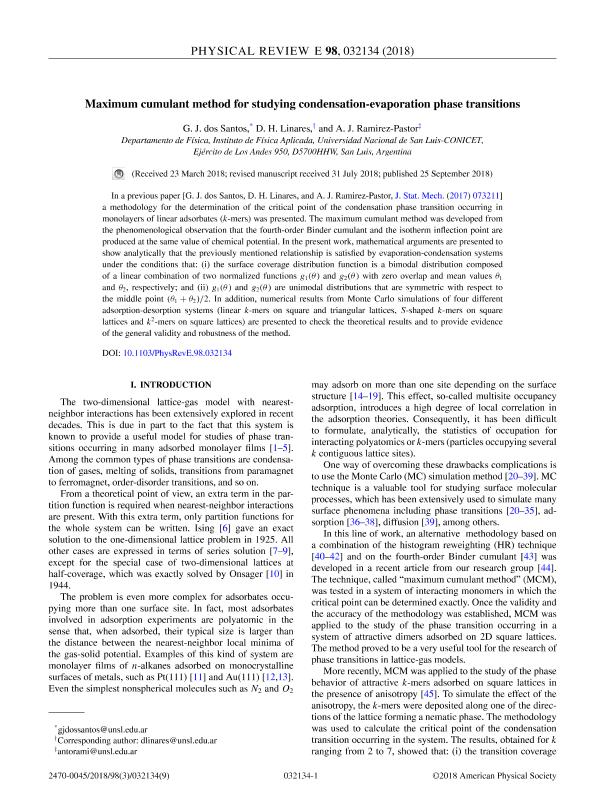Artículo
Maximum cumulant method for studying condensation-evaporation phase transitions
Fecha de publicación:
09/2018
Editorial:
American Physical Society
Revista:
Physical Review E
ISSN:
2470-0053
Idioma:
Inglés
Tipo de recurso:
Artículo publicado
Clasificación temática:
Resumen
In a previous paper [G. J. dos Santos, D. H. Linares, and A. J. Ramirez-Pastor, J. Stat. Mech. (2017) 07321110.1088/1742-5468/aa7df2] a methodology for the determination of the critical point of the condensation phase transition occurring in monolayers of linear adsorbates (k-mers) was presented. The maximum cumulant method was developed from the phenomenological observation that the fourth-order Binder cumulant and the isotherm inflection point are produced at the same value of chemical potential. In the present work, mathematical arguments are presented to show analytically that the previously mentioned relationship is satisfied by evaporation-condensation systems under the conditions that: (i) the surface coverage distribution function is a bimodal distribution composed of a linear combination of two normalized functions g1(θ) and g2(θ) with zero overlap and mean values θ1 and θ2, respectively; and (ii) g1(θ) and g2(θ) are unimodal distributions that are symmetric with respect to the middle point (θ1+θ2)/2. In addition, numerical results from Monte Carlo simulations of four different adsorption-desorption systems (linear k-mers on square and triangular lattices, S-shaped k-mers on square lattices and k2-mers on square lattices) are presented to check the theoretical results and to provide evidence of the general validity and robustness of the method.
Palabras clave:
CONDENSATION-EVAPORATION
,
PHASE TRANSITIONS
,
MONTE CARLO METHODS
Archivos asociados
Licencia
Identificadores
Colecciones
Articulos(CCT - SAN LUIS)
Articulos de CTRO.CIENTIFICO TECNOL.CONICET - SAN LUIS
Articulos de CTRO.CIENTIFICO TECNOL.CONICET - SAN LUIS
Articulos(INFAP)
Articulos de INST. DE FISICA APLICADA "DR. JORGE ANDRES ZGRABLICH"
Articulos de INST. DE FISICA APLICADA "DR. JORGE ANDRES ZGRABLICH"
Citación
Dos Santos Mendez, Gonzalo Joaquín; Linares, Daniel Humberto; Ramirez Pastor, Antonio Jose; Maximum cumulant method for studying condensation-evaporation phase transitions; American Physical Society; Physical Review E; 98; 3; 9-2018; 1-9
Compartir
Altmétricas




